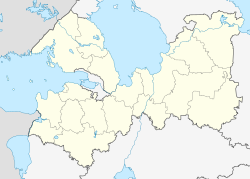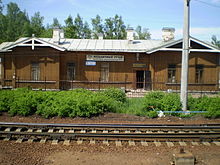Town in Leningrad Oblast, Russia
| Vsevolozhsk Всеволожск | |
|---|---|
| Town | |
 Vsevolozhsk as seen from the sixteenth floor of an apartment building Vsevolozhsk as seen from the sixteenth floor of an apartment building | |
 Flag Flag Coat of arms Coat of arms | |
| Location of Vsevolozhsk | |
  | |
| Coordinates: 60°02′N 30°40′E / 60.033°N 30.667°E / 60.033; 30.667 | |
| Country | Russia |
| Federal subject | Leningrad Oblast |
| Administrative district | Vsevolozhsky District |
| Settlement municipal formation | Vsevolozhskoye Settlement Municipal Formation |
| Founded | 1892 |
| Elevation | 30 m (100 ft) |
| Population | |
| • Total | 59,704 |
| • Rank | 275th in 2010 |
| Administrative status | |
| • Capital of | Vsevolozhsky District, Vsevolozhskoye Settlement Municipal Formation |
| Municipal status | |
| • Municipal district | Vsevolozhsky Municipal District |
| • Urban settlement | Vsevolozhskoye Urban Settlement |
| • Capital of | Vsevolozhsky Municipal District, Vsevolozhskoye Urban Settlement |
| Time zone | UTC+3 (MSK |
| Postal code(s) | 188640–188645, 188649, 188699 |
| OKTMO ID | 41612101001 |
| Website | www |
Vsevolozhsk (Russian: Все́воложск, IPA: [ˈfsʲevələʂsk]; Finnish: Seuloskoi) is a town and the administrative center of Vsevolozhsky District in Leningrad Oblast, Russia, located on the Karelian Isthmus 24 kilometers (15 mi) east of St. Petersburg. Population: 59,704 (2010 Census); 45,310 (2002 Census); 31,946 (1989 Soviet census).
| Year | Pop. | ±% |
|---|---|---|
| 1926 | 1,324 | — |
| 1939 | 11,848 | +794.9% |
| 1959 | 27,768 | +134.4% |
| 1970 | 26,978 | −2.8% |
| 1979 | 28,588 | +6.0% |
| 1989 | 31,946 | +11.7% |
| 2002 | 45,310 | +41.8% |
| 2010 | 59,704 | +31.8% |
| 2021 | 79,038 | +32.4% |
| Source: Census data | ||
The town's name comes from manufacturer Vsevolozhsky. In 1941–1944, the vital road connecting besieged Leningrad with the rest of Soviet Union, the Road of Life, passed through the town. Currently, a considerable part of the population of Vsevolozhsk commutes to St. Petersburg for work, which is facilitated by the wide-scale construction of apartment buildings in the town.
History
A number of villages historically existed within the current area of the town of Vsevolozhsk. In particular, the village of Ryabovo was first mentioned in 1727. From the end of the 18th century and into the 19th century, Ryabovo belonged to the family of nobles of Vsevolozhsky, after whom the town was eventually named. In 1892, a narrow-gauge railway (Irinovskaya railway), the first such line in Russia, was constructed to transport peat for St. Petersburg's heating. A number of railway stations were opened, including Berngardovka, Vsevolozhskaya, and Melnichny Ruchey. Settlements eventually developed around the stations. The whole area was a part of Shlisselburgsky Uyezd of St. Petersburg Governorate. The settlement of Vsevolozhskoye, around Vsevolozhskaya railway station, was the first settlement in Russia where street gas lamps were installed. On February 14, 1923, Shlisselburgsky Uyezd was merged into Petrogradsky Uyezd. In January 1924, the uyezd and the governorate were renamed Leningradsky.
On August 1, 1927, the uyezds were abolished and Leninsky District, with the administrative center in the settlement of Vsevolozhskoye, was established. The governorates were also abolished and the district became a part of Leningrad Okrug of Leningrad Oblast. On August 15, 1930, the okrugs were abolished as well and the districts were directly subordinated to the oblast. In May 1930, Vsevolozhskaya, Berngardovka, Ilyinsky, Maryino, and Ryabovo were all granted suburban settlement status. On August 19, 1930, Leninsky District was abolished and merged into newly established Leningradsky Prigorodny District with the administrative center in the city of Leningrad. On August 19, 1936, Leningradsky Prigorodny District was abolished and Vsevolozhsky District, with the administrative center in Vsevolozhskoye, was established. On November 27, 1938, the suburban settlements of Vsevolozhskaya, Berngardovka, Ilyinsky, Maryino, and Ryabovo were merged into the urban-type settlement of Vsevolozhsky, which became the administrative center of the district. On February 1, 1963, the urban-type settlement of Vsevolozhsky was renamed Vsevolozhsk and granted the status of town of oblast significance. In 2010, the administrative structure of Leningrad Oblast was harmonized with its municipal structure, and Vsevolozhsk became the town of district significance.
Administrative and municipal status
Within the framework of administrative divisions, Vsevolozhsk serves as the administrative center of Vsevolozhsky District. As an administrative division, it is, together with three rural localities, incorporated within Vsevolozhsky District as Vsevolozhskoye Settlement Municipal Formation. As a municipal division, Vsevolozhskoye Settlement Municipal Formation is incorporated within Vsevolozhsky Municipal District as Vsevolozhskoye Urban Settlement.
Economy
Industry
Industrial companies in Vsevolozhsk include:
- Rexam PLC Beverage Can Europe and Asia, the world's leading manufacturer of beverage cans
- Ford automobile assembly plant (now closed as of 2019)
- Nokian Tyres tire manufacture
- "MDM-print" printing house
- Merloni TermoSanitari S.p.A., factory producing water-heaters
- Nevsky ceramics factory
- meat-processing factory
- milk factory
- sewing factory
- furniture and construction materials plants
Transportation

In Vsevolozhsk, there are three railway stations, Berngardovka, Vsevolozhskaya, and Melnichny Ruchey. Southbound trains arrive to Finlyandsky Rail Terminal in St. Petersburg. Northbound suburban trains terminate on the stations Nevskaya Dubrovka or Ladozhskoye Ozero. Melnichny Ruchey also serves as the terminal station for suburban trains.
Vsevolozhsk is essentially a suburb of St. Petersburg and is included in the suburban road network.
Education
The town has six schools of general education, music school, art school, and two vocational schools.
Culture and recreation
The town contains eleven cultural heritage monuments of federal significance and additionally thirty-five objects classified as cultural and historical heritage of local significance. These include the Priyutino Estate and the Ryabovo Estate, as well as monuments related to the Road of Life, which was connecting Leningrad with the rest of Soviet Union during the Siege of Leningrad in 1941–1944.
Vsevolozhsk State Museum of History displays collections of local interest. The Priyutino Estate, which belonged to Alexey Olenin, the President of the Imperial Academy of Arts in the 19th century, is a museum as well.
There was an intention to make a resort in the town in the Soviet times. For that purpose a ski jump was built (now dysfunctional), but later this idea was abandoned.
Notable people
- Vladimir Belousov, former ski jumper, Olympic gold medalist
References
Notes
- ^ Oblast Law #32-oz
- ^ Russian Federal State Statistics Service (2011). Всероссийская перепись населения 2010 года. Том 1 [2010 All-Russian Population Census, vol. 1]. Всероссийская перепись населения 2010 года (in Russian). Federal State Statistics Service.
- ^ Law #17-oz
- "Об исчислении времени". Официальный интернет-портал правовой информации (in Russian). June 3, 2011. Retrieved January 19, 2019.
- Почта России. Информационно-вычислительный центр ОАСУ РПО. (Russian Post). Поиск объектов почтовой связи (Postal Objects Search) (in Russian)
- Federal State Statistics Service (May 21, 2004). Численность населения России, субъектов Российской Федерации в составе федеральных округов, районов, городских поселений, сельских населённых пунктов – районных центров и сельских населённых пунктов с населением 3 тысячи и более человек [Population of Russia, Its Federal Districts, Federal Subjects, Districts, Urban Localities, Rural Localities—Administrative Centers, and Rural Localities with Population of Over 3,000] (XLS). Всероссийская перепись населения 2002 года (in Russian).
- Всесоюзная перепись населения 1989 г. Численность наличного населения союзных и автономных республик, автономных областей и округов, краёв, областей, районов, городских поселений и сёл-райцентров [All Union Population Census of 1989: Present Population of Union and Autonomous Republics, Autonomous Oblasts and Okrugs, Krais, Oblasts, Districts, Urban Settlements, and Villages Serving as District Administrative Centers]. Всесоюзная перепись населения 1989 года (in Russian). Институт демографии Национального исследовательского университета: Высшая школа экономики . 1989 – via Demoscope Weekly.
- История (in Russian). Официальный сайт МО "Город Всеволожск". Retrieved March 19, 2014.
- ^ Петроградский уезд (1917 г. - январь 1924 г.), Ленинградский уезд (январь 1924 г. - август 1927 г.) (in Russian). Система классификаторов исполнительных органов государственной власти Санкт-Петербурга. Retrieved March 19, 2014.
- ^ Ленинский район Ленинградского округа (август 1927 г. - август 1930 г.) (in Russian). Система классификаторов исполнительных органов государственной власти Санкт-Петербурга. Retrieved March 19, 2014.
- Ленинградская область (in Russian). Справочник по истории Коммунистической партии и Советского Союза 1898 - 1991. Retrieved March 6, 2014.
- ^ Ленинградский Пригородный район (август 1930 г. - август 1936 г.) (in Russian). Система классификаторов исполнительных органов государственной власти Санкт-Петербурга. Retrieved March 19, 2014.
- ^ Всеволожский район (август 1936 г.) (in Russian). Система классификаторов исполнительных органов государственной власти Санкт-Петербурга. Retrieved March 19, 2014.
- Отчет о работе комитета по взаимодействию с органами местного самоуправления Ленинградской области в 2010 году (in Russian). Комитет по печати и связям с общественностью Ленинградской области. Retrieved November 16, 2012.
- Памятники истории и культуры народов Российской Федерации (in Russian). Russian Ministry of Culture. Retrieved June 2, 2016.
- Всеволожский государственный историко-краеведческий музей (in Russian). Российская сеть культурного наследия. Retrieved April 9, 2013.
- Литературно-художественный музей-усадьба "Приютино" (in Russian). Российская сеть культурного наследия. Retrieved April 9, 2013.
- Vsevolozhsk Всеволожск
Sources
- Законодательное собрание Ленинградской области. Областной закон №32-оз от 15 июня 2010 г. «Об административно-территориальном устройстве Ленинградской области и порядке его изменения», в ред. Областного закона №23-оз от 8 мая 2014 г. «Об объединении муниципальных образований "Приморское городское поселение" Выборгского района Ленинградской области и "Глебычевское сельское поселение" Выборгского района Ленинградской области и о внесении изменений в отдельные Областные законы». Вступил в силу со дня официального опубликования. Опубликован: "Вести", №112, 23 июня 2010 г. (Legislative Assembly of Leningrad Oblast. Oblast Law #32-oz of June 15, 2010 On the Administrative-Territorial Structure of Leningrad Oblast and on the Procedures for Its Change, as amended by the Oblast Law #23-oz of May 8, 2014 On Merging the Municipal Formations of "Primorskoye Urban Settlement" in Vyborgsky District of Leningrad Oblast and "Glebychevskoye Rural Settlement" in Vyborgsky District of Leningrad Oblast and on Amending Various Oblast Laws. Effective as of the day of the official publication.).
- Законодательное собрание Ленинградской области. Областной закон №17-оз от 10 марта 2004 г. «Об установлении границ и наделении соответствующим статусом муниципальных образований Всеволожский район и Выборгский район и муниципальных образований в их составе», в ред. Областного закона №23-оз от 8 мая 2014 г. «Об объединении муниципальных образований "Приморское городское поселение" Выборгского района Ленинградской области и "Глебычевское сельское поселение" Выборгского района Ленинградской области и о внесении изменений в отдельные Областные законы». Вступил в силу со дня официального опубликования. Опубликован: "Вести", №27, 11 марта 2004 г. (Legislative Assembly of Leningrad Oblast. Oblast Law #17-oz of March 10, 2004 On Establishing the Borders of and Granting an Appropriate Status to the Municipal Formations of Vsevolozhsky District and Vyborgsky District and to the Municipal Formations Comprising It, as amended by the Oblast Law #23-oz of May 8, 2014 On Merging the Municipal Formations of "Primorskoye Urban Settlement" in Vyborgsky District of Leningrad Oblast and "Glebychevskoye Rural Settlement" in Vyborgsky District of Leningrad Oblast and on Amending Various Oblast Laws. Effective as of the day of the official publication.).
External links
- (in Russian) Official website of Vsevolozhsk
- (in Russian) Unofficial website of Vsevolozhsk